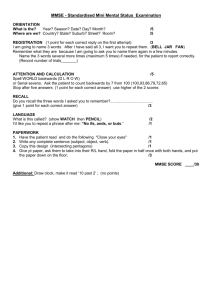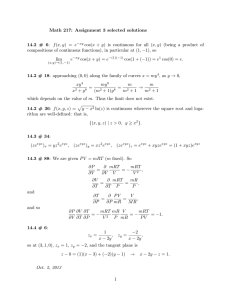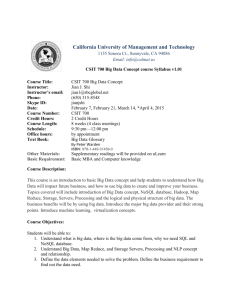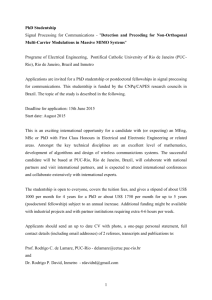Performance Analysis of Massive MIMO with Different Precoders under Perfect and
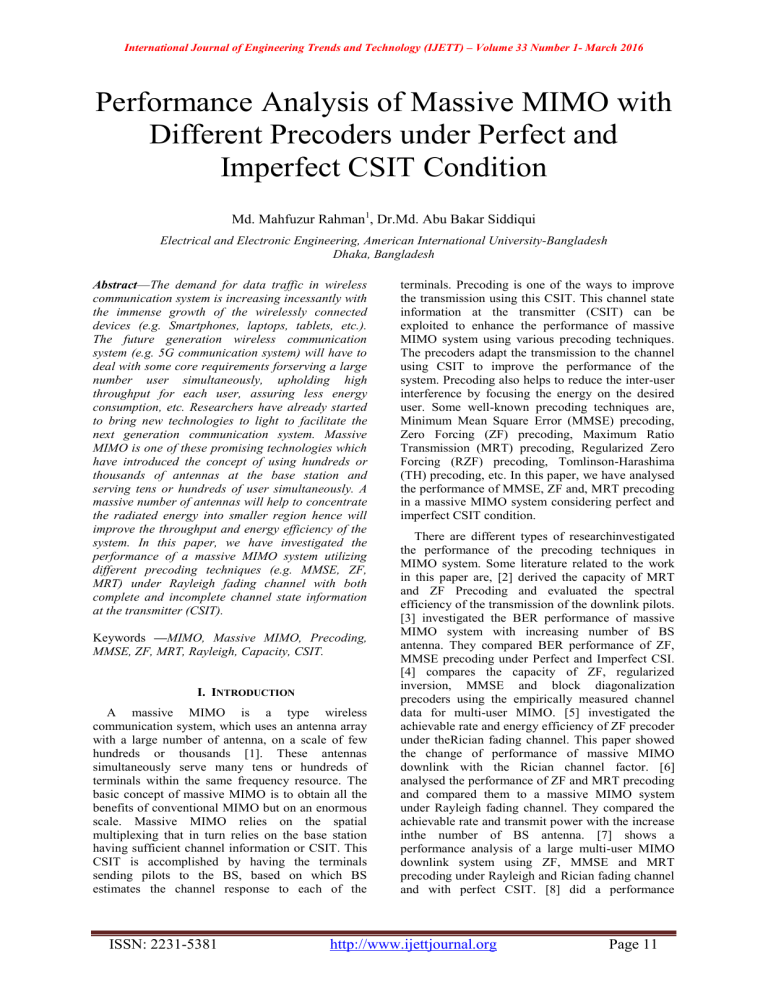
International Journal of Engineering Trends and Technology (IJETT) – Volume 33 Number 1- March 2016
Performance Analysis of Massive MIMO with
Different Precoders under Perfect and
Imperfect CSIT Condition
Md. Mahfuzur Rahman
1
, Dr.Md. Abu Bakar Siddiqui
Electrical and Electronic Engineering, American International University-Bangladesh
Dhaka, Bangladesh
Abstract — The demand for data traffic in wireless communication system is increasing incessantly with the immense growth of the wirelessly connected devices (e.g. Smartphones, laptops, tablets, etc.).
The future generation wireless communication system (e.g. 5G communication system) will have to deal with some core requirements forserving a large number user simultaneously, upholding high throughput for each user, assuring less energy consumption, etc. Researchers have already started to bring new technologies to light to facilitate the next generation communication system. Massive
MIMO is one of these promising technologies which have introduced the concept of using hundreds or thousands of antennas at the base station and serving tens or hundreds of user simultaneously. A massive number of antennas will help to concentrate the radiated energy into smaller region hence will improve the throughput and energy efficiency of the system. In this paper, we have investigated the performance of a massive MIMO system utilizing different precoding techniques (e.g. MMSE, ZF,
MRT) under Rayleigh fading channel with both complete and incomplete channel state information at the transmitter (CSIT).
Keywords — MIMO, Massive MIMO, Precoding,
MMSE, ZF, MRT, Rayleigh, Capacity, CSIT.
I.
I NTRODUCTION
A massive MIMO is a type wireless communication system, which uses an antenna array with a large number of antenna, on a scale of few hundreds or thousands [1]. These antennas simultaneously serve many tens or hundreds of terminals within the same frequency resource. The basic concept of massive MIMO is to obtain all the benefits of conventional MIMO but on an enormous scale. Massive MIMO relies on the spatial multiplexing that in turn relies on the base station having sufficient channel information or CSIT. This
CSIT is accomplished by having the terminals sending pilots to the BS, based on which BS estimates the channel response to each of the terminals. Precoding is one of the ways to improve the transmission using this CSIT. This channel state information at the transmitter (CSIT) can be exploited to enhance the performance of massive
MIMO system using various precoding techniques.
The precoders adapt the transmission to the channel using CSIT to improve the performance of the system. Precoding also helps to reduce the inter-user interference by focusing the energy on the desired user. Some well-known precoding techniques are,
Minimum Mean Square Error (MMSE) precoding,
Zero Forcing (ZF) precoding, Maximum Ratio
Transmission (MRT) precoding, Regularized Zero
Forcing (RZF) precoding, Tomlinson-Harashima
(TH) precoding, etc. In this paper, we have analysed the performance of MMSE, ZF and, MRT precoding in a massive MIMO system considering perfect and imperfect CSIT condition.
There are different types of researchinvestigated the performance of the precoding techniques in
MIMO system. Some literature related to the work in this paper are, [2] derived the capacity of MRT and ZF Precoding and evaluated the spectral efficiency of the transmission of the downlink pilots.
[3] investigated the BER performance of massive
MIMO system with increasing number of BS antenna. They compared BER performance of ZF,
MMSE precoding under Perfect and Imperfect CSI.
[4] compares the capacity of ZF, regularized inversion, MMSE and block diagonalization precoders using the empirically measured channel data for multi-user MIMO. [5] investigated the achievable rate and energy efficiency of ZF precoder under theRician fading channel. This paper showed the change of performance of massive MIMO downlink with the Rician channel factor. [6] analysed the performance of ZF and MRT precoding and compared them to a massive MIMO system under Rayleigh fading channel. They compared the achievable rate and transmit power with the increase inthe number of BS antenna. [7] shows a performance analysis of a large multi-user MIMO downlink system using ZF, MMSE and MRT precoding under Rayleigh and Rician fading channel and with perfect CSIT. [8] did a performance
ISSN: 2231-5381 http://www.ijettjournal.org
Page 11
International Journal of Engineering Trends and Technology (IJETT) – Volume 33 Number 1- March 2016 analysis of massive MIMO downlink with ZF precoding.
Following the on-going researches provided, this work offers a comprehensive performance analysis of a massive MIMO downlink system with different precoding such as MMSE, ZF and MRT under perfect and imperfect CSIT condition. Rest of the paper is organized as, in Section II,provides a system model of a MIMO system, and shows the equation for theachievable rate of a user in MIMO system.
Section III, describes the precoding techniques used in this work. Section IV gives a short description of perfect and imperfect CSIT. It also represents the
CSI assumption to assume the imperfect or incomplete CSI values. Section V discusses the research methodology of this work. This methodologyincludes the process how the capacity and BER of the system is obtained. All the simulation results are presented and analysed in
Section VI. Section VII draws a conclusion to the paper and discusses some future work plan.
II.
S YSTEM M ODEL
Let us consider a single cell massive MIMO system with a base station equipped with Nt number of transmit antenna serving Nu number of singleantenna user terminals. The received complex baseband signal y can be written as,
H y H s n
(1) where, y Nu 1
, s Nt 1
is the transmitted message signal vector,
H Nu Nt
is the channel gain matrix, n Nu 1 is the additive white Gaussian noise vector and,
is the set of all complex numbers. Now, if the transmitter is power constrained, then tr ss
H
[ ( )] P tr
, where, P tr is the total transmit power available at the transmitter. Also, nn
H
[( )]
2
I
Nu
, where,
2
is the noise variance at the receive antenna. The average received signal-to-noise ratio (SNR) can be given as,
SNR P tr
/
2
. Now let,
P Nt Nu
be the precoding matrix and x is an
Nu 1
information vector. Therefore, the transmitter vector s can be written as, s Px
Therefore, Eq (1) can be written as,
(2)
H y H Px n
(3) u
H h p x u
2 u
H h p u
2 x u
2
Now, let y u
and x u
be the u th elements of the
Nu× 1 vectors y and x respectively. Then, y u can be expressed as,
Nu y u u
H h p x u u
H i n u
(4) i 1, i u
The energy of the desired signal in (4) is given by,
H
2 h p (5) u u
The inter-user interference plus noise energy of (4) can be written as,
2
Nu i 1, i u h p x n u i i u
Nu i 1, i u h p u i
2 x i
2 u
2 n
Nu i 1, i u h p u i
2
1 (6)
Now, from Shannon theorem, the channel capacity over Additive Gaussian Noise Channel is defined by,
R SNR ) ( bit/s/Hz)
Then, the achievable rate of u th user for the massive MIMO downlink system can be expressed as,
ISSN: 2231-5381 http://www.ijettjournal.org
Page 12
International Journal of Engineering Trends and Technology (IJETT) – Volume 33 Number 1- March 2016
R u
1
2 u u
Nu h p i
2 i 1, i u
(7)
III.
P RECODING T ECHNIQUES
A.
Minimum Mean Square Error (MMSE)
The MMSE precoding technique is generated by using the mean square error (MSE) method. Keeping the average transmitted power at each transmitted antenna at the BS is constrained.
Precoding matrix for MMSE precoding can be written as [7],
P
MMSE
1
H
H ( HH
H
Nu
I
Nu
)
P tr
1
(8)
Therefore, the received vector with MMSE precoding can be written as,
1 y
1
H H
H
HH
H
Nu
I
Nu
P tr x n
(9) where,
(
H
(
HH
H
Nu
I
Nu
P
tr
P
tr
Now, let, y u
, x u
, n u
be the u th elements of
Nu
×
1 vectors y, x, and n respectively and the u th column
of P
MMSE is defined as, p H u
H u
(10) where, is the u th column of u
H
Nu
1
( HH I
Nu
)
. Therefore, from, (9) the
P tr received vector of u th
user with MMSE is given by, y u
1
H h H x u u u
1 Nu i 1, i u
H h H x n u i i u
(11)
Therefore, the achievable rate of the u th user with
MMSE precoding is given by,
R u
MMSE
log
2
1
1
1
2
1
2
Nu i 1, i u
H u
2
H i
2
(12)
B.
Zero Forcing (ZF)Precoding
ZF is one of the precoding techniques in which the inter-user interference can be cancelled out by each user. This precoding is assumed to implement a pseudo-inverse of the channel matrix. The precoding matrix for ZF precoding can be written as [7],
P
ZF
1
H
H ( HH
H
)
1
(13) where,
P tr
H
) where, B H
H
( HH
H
)
1
Therefore, the received vector with ZF precoding can be written as, y
1
H H H ( HH H ) 1 x n (14) where,
H
( ( HH
H
)
2
P tr
Now let, y x u u and, n be the u u th elements of
Nu
×
1 vectors y, x, and n respectively and we define the u th column of P
ZF as,
H p H g u u
(15) where, g
is the u th column of u
( HH H ) 1
. From
(4), the received signal vector of u th user with ZF precoding is given as, y u
1 u
H h H g x
1 Nu i 1, i u u
H i i n u
(16)
ISSN: 2231-5381 http://www.ijettjournal.org
Page 13
International Journal of Engineering Trends and Technology (IJETT) – Volume 33 Number 1- March 2016
The achievable rate of u th
user with ZF precoding technique is written as,
R u
ZF
1
2 u
H h H g u
2 log 1
2
1
1 Nu i 1, i u
(17)
H h H g u i
2
C.
Maximum Ratio Transmission (MRT)
MRT is one of the commonmethods which maximizes the SNR. The precoding matrix for MRT precoding can be written as,
P
MRT
1
H
H (18) where,
P tr
H
) where, B =H
H
From (3), the received vector for MRT precoding can be written as, y
1
HH x n
(19) where,
Let, y x u u
and n
be the u u th elements of Nu
×
1 vectors y, x, and n respectively and the u th column of
P
MRT
can be written as,
H p h u u
(20)
From, (4), the received vector of u th user with
MRT precoding technique can be written as,
1 1 Nu y u u u u h h x n u i u u i 1, i u
(21)
Therefore, the achievable rate of u th
user with MRT precoding technique can be written as,
R u
MRT
P tr
H )
1
1
2 h u
2
1
2
Nu i 1, i u
H
2
(22)
IV.
C HANNEL S TATE I NFORMATION
A.
Perfect and Imperfect CSIT
Perfect CSIT means that the transmitter knows all the components of H instantaneously and without errors. In an ideal scenario like this, the performance of the system can be increased very much using the
CSIT. It is in fact, impossible to achieve perfect
CSIT because the transmission should be instantaneous, the precision of the electronics should be infinite, and some other hypothesis that in the reality are impossible. To be more realistic it can be considered that the CSI is incomplete. It means that only a part of the channel is unknown. It can be due to some user not knowing its channel. Then a whole row of H is missing. Or due to some resources constraints in the system that doesn't let know a specific amount of information of the channel.It can also be originated because an error on the obtainment of the CSI or a quantification error. An example of the imperfectCSIT could be like this,
H h h h h h h
11 12 13 14 15 16 h h h h h h
21 22 23 24 25 26 h
33 h h h h h h
41 42 43 44 45 46 h
55
In this example, it can be seen that the users 1, 2 and
4 transmit all the CSI but users 3 and 5 just transmit the information only for the path from antenna 3 and
6 respectively.
B.
Assumption of Channel State Information
If the channel state information at the transmitter
(CSIT) is not perfect, there are two options, first is not to perform any precoding and using old transmission using other techniques rather than
MIMO techniques, second is the missing values of the CSIT can be assumed. The missing information can be obtained using statistical properties or assuming there is no noise in the channel. In this work, three types of hypothetical assumption are considered to assumethe missing information of the
CSIT and analysed the performance of the precoders using these assumptions. The assumptions are,
1. Ones Assumption: Ones assumption assumesa perfect channel. It fills the gap in CSIT matrix with ones. This assumption is used when there is no correlation information in the transmission side.
ISSN: 2231-5381 http://www.ijettjournal.org
Page 14
International Journal of Engineering Trends and Technology (IJETT) – Volume 33 Number 1- March 2016
2. Mean Assumption: In this types of assumption, the mean of the paths of each antenna is used to get the unknown or incomplete CSI. If the channel is consideredGaussian with zero means, anaverage of a lot of value tends to be zero.
3. Random Assumption: In this assumption, the incomplete components of the CSI are replaced by random number with the same distribution as the channel.
V.
R ESEARCH M ETHODOLOGY
The performance analysis is done in two steps.
First, the capacity of the system is found in various cases. And second, the BER performance is investigated for different precoders. capacity of the system are, generating channel, defining precoding matrices with their power constraints, calculating SINR for each user, calculating the achievable rate of each user, calculating total capacity of all users hence total capacity of the system and finally taking an average of all realization (in this paper 1000) to find the final system capacity.
To find the BER performance, a random message signal is generated and transmitted using QPSK
(Quadrature Phase Shift Keying) modulation. Before transmission, the message signal is precoded using different precoding techniques mentioned in section
III. The total process is shown in Figure 2.
Figure 1.
Flow chart for the simulation of capacity analysis
Figure 1 shows the flow diagram to calculate the capacity of the system. Main steps of calculating the
Figure 2.
Flow chart to find the BER performance of the system
Values of different parameters used for simulation is given in Table I.
Table I: Value of different parameters
Parameter
SNR (When Fixed)
SNR (Range)
Number of BS Antenna
(Fixed)
Values
10dB
-20 to 20 dB, 0 to 20 dB
32
ISSN: 2231-5381 http://www.ijettjournal.org
Page 15
International Journal of Engineering Trends and Technology (IJETT) – Volume 33 Number 1- March 2016
Range of BS antenna
(When varied)
Number of users (Fixed)
Range of User (When varied)
Number of user with incomplete CSI (Fixed)
Number of user with incomplete CSI (varied)
Number of realization
Number of frames
Number of packets
Number of bit for QPSK symbol
30 to 100
14
5 to 30
5
1 to 13
1000
10
200
2
VI.
R ESULTS AND A NALYSIS
We have done the performance analysis simulation for four different cases such as,
Case 1.
Change in capacity with the increase of
SNR.
Case 2.
Change in capacity with the increase of the number of Base station antenna.
Case 3.
Change in capacity with the increase of the number of users. Lastly,
Case 4.
Change in capacity with the increase of a number of user having incomplete CSIT.
And secondly, we have shown the bit error rate performance (BER) of the precoding techniques. All simulation is done under Rayleigh Channel Model.
MRT precoding starts to fall. For high SNR (i.e. 0-
20 dB in this figure), MMSE and ZF perform much better than MRT. At 20 dB, the capacity using MRT precoding is about 25bit/s/Hz whereas, the capacity of MMSE and ZF are about 98bit/s/Hz.
In Figure 4, the CSIT of the system is considered incomplete, and ones assumption is applied as mentioned in section IV. Due to imperfect CSIT, the capacity of all precoder falls than the capacity with perfect CSIT. In this case, ZF performs worst among the three precoders in the low SNR region and a large portion of high SNR region (i.e. 0-15dB). For example, at 5dB, the capacity using MMSE and
MRT precoding are about 18bit/s/Hz and 14bit/s/Hz respectively whereas, capacity with ZF precoding is about 6bit/z/Hz. After 15dB, ZF again starts to perform better than MRT.
Figure 4.
System capacity with the increase of SNR under incomplete CSIT and ones assumption
Figure 3.
Change in system capacity with the increase of SNR with perfect CSIT
Figure 3 shows the change in capacity with the increase of SNR with different precoding under perfect CSIT condition and for a 32
×
14 system. In this figure, for low SNR MMSE and MRT precoding performs similarly and better than ZF precoding. As soon as, The SNR crossed the 0dB, the capacity with
Figure 5.
System capacity with the increase of SNR under incomplete CSIT and random assumption
In the case of random assumption in Figure 5, similar to case 1, MRT performs similarly to MMSE at low SNR. And at high SNR, it agin falls behind.
Figure 6, shows the capacity with mean CSIT assumption. Similar to ones assumption, for a large portion of SNR (in this case, -20 to 9dB) MMSE and
ISSN: 2231-5381 http://www.ijettjournal.org
Page 16
International Journal of Engineering Trends and Technology (IJETT) – Volume 33 Number 1- March 2016
MRT perform better than ZF. For whole range
MMSE performs best among the three precoders.
Figure 6.
System capacity with the increase of SNR under incomplete CSIT and mean assumption
For the second case wherechange in capacityis presented with the increasein the number of BS antenna from 30 to 100 and keeping the number of users fixed at 14. From Figure 7, under perfect CSIT condition and 10dB SNR, MMSE and ZF performs much better than MRT. For example, with 30 BS antenna, MMSE and ZF gives about 52bit/s/Hz whereas, with MRT the capacity is 23bit/s/Hz again, with 100 antennas, ZF and MMSE have a capacity of 82bit/s/Hz.
Figure 8.
System capacity with the increase in number of BS antenna under incomplete CSIT and ones assumption
In case of random assumption in Figure 9, the behaviour of the precoder is almost same as perfect
CSIT condition shown in Figure 7, except the capacity in this case is slightly less. Here, MMSE and ZF performs better than MRT.
Figure 7.
System capacity with the increase of number of BS antenna with perfect CSIT
Now with imperfect CSIT and ones assumption in
Figure 8, ZF falls much more behind MMSE and
MRT. Even, for some number of BS antenna the capacity falls the below the average capacity (in this case for 35, 60, 65 BS antenna the capacity falls than the average). Therefore, the performance of ZF is unstable in this case.
Figure 9.
System capacity with the increase of BS antenna under incomplete CSIT and random assumption
Now, with mean assumption in Figure 10, MMSE performs as it is as Figure 7 and 9 but, this time ZF performs close to MRT instead of MMSE. It performs slighly better than MRT.
ISSN: 2231-5381 http://www.ijettjournal.org
Page 17
International Journal of Engineering Trends and Technology (IJETT) – Volume 33 Number 1- March 2016
(e.g. In this case, for 10, 14, 23 and 26 capacity of
ZF falls below the average). MMSE still performs best among the three.
Figure 10.
System capacity with the increase of BS antenna under incomplete CSIT and mean assumption
In case 3, the change in capacity is presented with the increasein the number of users and keeping the number of BS antenna fixed at 34. From Figure 11, the capacity of the precoder increases with the increase of the number of theuser. After a certain number of users, the capacitystarts to fall. For example, in this figure, capacity using MMSE precoding begins to fall after 25 number of user and
ZF fall after reaching about 17 users. MRT does not fallin the whole region, the capacity of MRT precoder is always increasing with the number of theusers but the value of capacity is much less than
MMSE and ZF. Although after a certain number of
ZF falls behind MRT agin. In Figure11 after reaching close to 30 capacity of ZF become less than
MRT.
Figure 12.
Capacity of the system with the increase in the number of user under incomplete CSIT and ones assumption
In Figure 13 for therandomassumption, It shows asimilar pattern as perfect CSIT except the decreased capacity. In this case, the performance of
MRT precoding become close to MMSE and ZF. In another word, the performance of MRT is less affected by random assumption than ZF and MMSE.
Figure 11.
System capacity with the increase of number of user with perfect CSIT
Now for ones assumption, again ZF performs worst as in Figure 8 and case 2. For a different number of users, ZF achieves lower capacity than the average
Figure 13.
System capacity with the increase of the number of user under incomplete CSIT and random assumption
For mean assumption in Figure 14, with the increase of a number ofuser the capacity of ZF drastically falls. Although, MMSE and MRT perform almost same asrandomassumption, after the number of antenna reaching about 13 the capacity of ZF falls behind MRT and continuously falls through the end.
ISSN: 2231-5381 http://www.ijettjournal.org
Page 18
International Journal of Engineering Trends and Technology (IJETT) – Volume 33 Number 1- March 2016
Figure 14.
System capacity with the increase of the number of user under incomplete CSIT and mean assumption
Finally, in case 4, the capacity is shown with the increaseina number of user having incomplete CSIT.
Figure 15 shows that, with the increased number of user with incomplete CSIT, the performance of all precoders decreases. In this figure, for ones assumption, MMSE and ZF start at a better position than MRT. with the Increase of the number of user with incomplete CSIT, the capacity of the system with MMSE and MRT become similar (in this figure after reaching 8user with incomplete CSIT). But ZF suffers for the whole range. After the number of user with incomplete CSIT reaches 3 the capacity of ZF precoding starts to fall behind MMSE and MRT. and continue falling till the end. In case of random assumption, ZF and MMSE perform better than
MRT. And with the increase ofa number of user with incomplete CSIT performance of three precoder falls. In this case, after reaching 8 number of user with incomplete CSI, MRT starts to show slightly better performance than MMSE and ZF.
Figure 16.
System capacity with the increase of number of user with incomplete CSIT under incomplete CSIT and random assumption
For mean assumption in Figure 17, at first, the capacity of the system with all the precoder start to fall. But after a while, the Capacity of ZF and
MMSE begins to increase except MRT, which continues decreasing with the number of the number of user with incomplete CSIT. MMSE start with the best performance among the three, ZF and MRT begin with almost same capacity performance. But with the increaseofthe number of users with incomplete CSIT, ZF tends to perform close to
MMSE precoding, MRT falls behind.
Figure 15.
System capacity with the increase of number of user with incomplete CSIT under incomplete CSIT and ones assumption
Figure 17.
System capacity with the increase of number of user with incomplete CSIT under incomplete CSIT and mean assumption
Finally, we have shown the BER performance of the system with different precoding techniques. From
Figure 18 it is observed thatat low SNR MRT performs better than MMSE and ZF. And high SNR
BER of MRT goes higher than MMSE and MRT.
Therefore, MRT performs better in low SNR in
ISSN: 2231-5381 http://www.ijettjournal.org
Page 19
International Journal of Engineering Trends and Technology (IJETT) – Volume 33 Number 1- March 2016 terms of bit error rate (BER) performance. MMSE shows the average performance for both high and low SNR.
Figure 18.
BER performance of the system with different precoding
Therefore, the summary of the results is, MMSE performs best in all cases. MRT performs better in low SNR than ZF, but at high SNR ZF performs better. Again this part is only valid for perfect CSIT.
Under imperfect CSIT, ZF suffers most among the three precoders. For ones assumption and mean assumption ZF suffers most. Considering all the factors, MMSE shows thebest performance in all purposes, it shows higher capacity and stable performance in all the cases. Then MRT performs better. Although the capacity is lower than MMSE
ZF in several cases, but the performance is consistent. And ZF is better than MRT in high SNR and perfect CSIT. But, in reality, perfect CSIT is not a possible option. Overall MMSE is the best option and after that MRT is the second best option among
MMSE, ZF and MRT precoding techniques.
VII.
C ONCLUSION AND F UTURE W ORK
According to the work was done by, Selvan, Iqbal, and Al-Raweshidy in [7], MRT performs better in low SNR and ZF performs better in high SNR. We have shown that ZF does not always perform better in high SNR. The performance depends on the availability of CSIT. Our future works will include, analysing the performance of massive MIMO in multicellular condition, find other limitations of this precoders and designing new precoding techniques with good overall performance in both perfect and imperfect CSIT condition.
R EFERENCES
[1] Larsson, Erik, Ove Edfors, Fredrik Tufvesson, and Thomas Marzetta, "Massive MIMO for next generation wireless systems," Communications
Magazine, IEEE, vol. 52, no. 2, pp. 186-195,
2014.
[2] Hien Quoc Ngo; Larsson, E.G.; Marzetta, T.L.,
"Massive MU-MIMO downlink TDD systems with linear precoding and downlink pilots," in
51st Annual Allerton Conference on
Communication, Control, and Computing
(Allerton) , Monticello, pp. 293-298, 2-4 October
2013.
[3] Marinello, José Carlos, and Taufik Abrão, BER
Analysis of Multi-Cellular MIMO Systems with
Increasing Number of BS Antennas, arXiv preprint arXiv:1406.3753, 2014.
[4] Kaltenberger, F.; Kountouris, M.; Cardoso, L.;
Knopp, R.; Gesbert, D., "Capacity of linear multi-user MIMO precoding schemes with measured channel data," in IEEE 9th Workshop on Signal Processing Advances in Wireless
Communications, SPAWC , Recife, pp. 580-584,
6-9 July 2008.
[5] Chuili Kong; Caijun Zhong; Matthaiou, M.;
Zhaoyang Zhang, "Performance of downlink massive MIMO in ricean fading channels with
ZF precoder," in IEEE International Conference on Communications (ICC) , London, pp. 1776-
1782, 8-12 June 2015.
[6] Parfait, T., Kuang, Y., & Jerry, K.,
"Performance analysis and comparison of ZF and MRT based downlink massive MIMO systems," in Sixth International Conf on
Ubiquitous and Future Networks (ICUFN) ,
Shanghai, China, pp. 383-388, 8th July 2014.
[7] Selvan, V.P.; Iqbal, M.S.; Al-Raweshidy, H.S.,
"Performance analysis of linear precoding schemes for very large Multi-user MIMO downlink system," in Fourth International
Conference on Innovative Computing
Technology (INTECH) , London, pp. 219-224,
13-15 August 2014.
[8] Zhao, Long, Kan Zheng, Hang Long, and Hui
Zhao, "Performance analysis for downlink massive MIMO system with ZF precoding,"
Transactions on Emerging Telecommunications
Technologies, vol. 25, no. 12, pp. 1219-1230,
2014.
ISSN: 2231-5381 http://www.ijettjournal.org
Page 20
